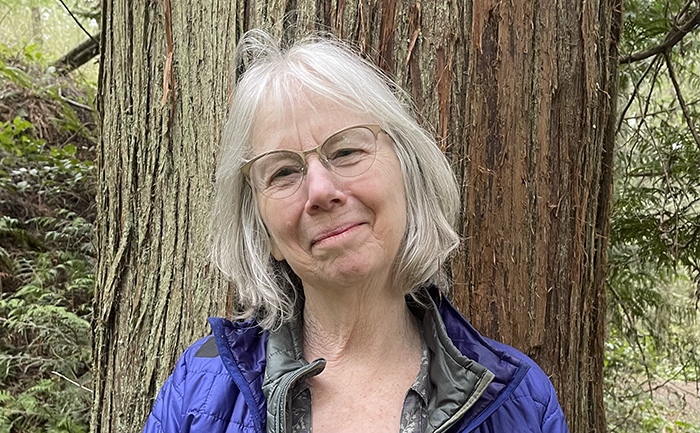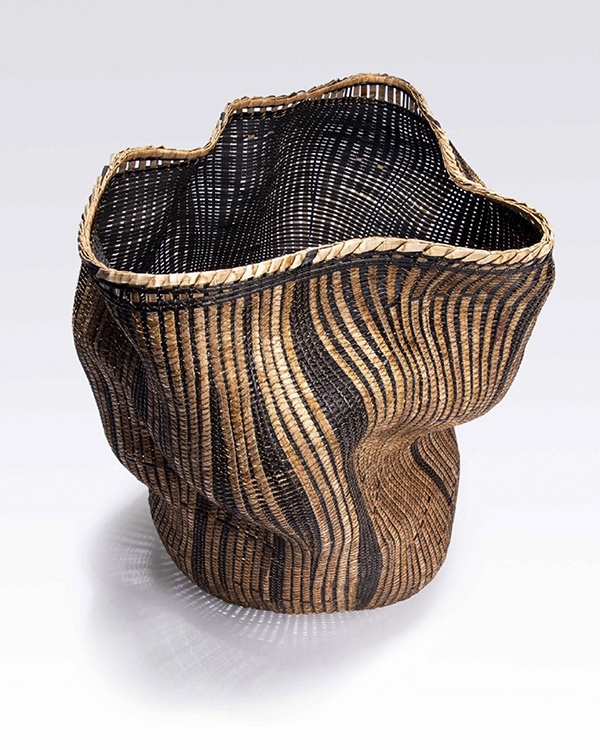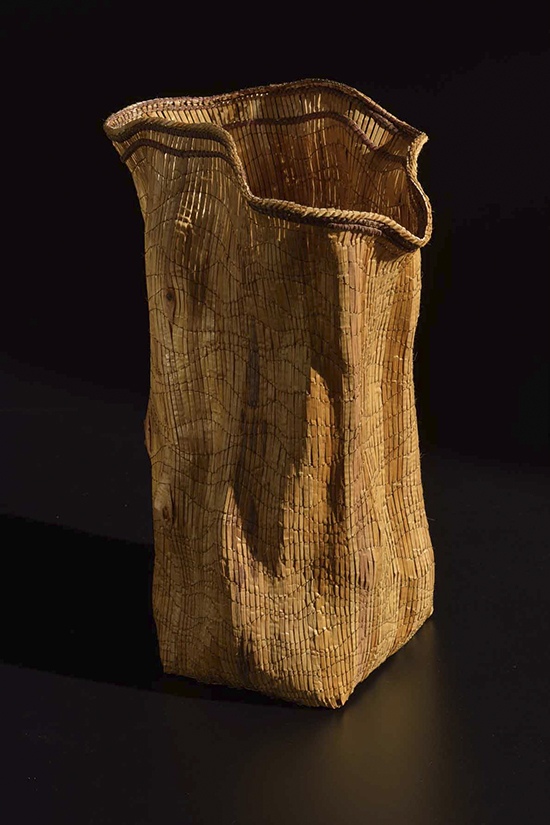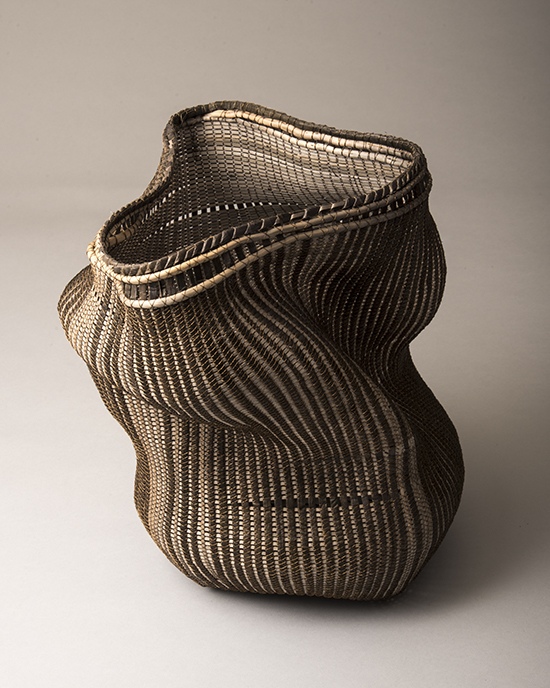
Polly Adams Sutton’s 'Ebb Tide': A Masterpiece of Contemporary Basketry
Polly Adams Sutton’s basketry piece ‘Ebb Tide’ was one of only 30 finalists from all over the world at the 2024 Loewe Foundation Craft Prize, and its captivating qualities make it easy to understand why. This basket is characterized by its organic, undulating form, suggesting movement and fluidity. It showcases a striking interplay between natural and black-dyed materials, enhancing its three-dimensional quality and making it an intriguing and beautiful example of contemporary basketry.

The inspiration for ‘Ebb Tide’ comes from the constant ebb and flow of ocean tides of the Salish Sea near Sutton’s home in the Pacific Northwest. Her craftsmanship is evident in her meticulous weaving technique, where natural fibers, primarily cedar bark, are skillfully interwoven with black cane or similar materials to form a complex and harmonious design. The basket’s edges are finished with a folded rim, adding both structural integrity and aesthetic appeal. Its asymmetrical shape, with curves and indentations, gives it a unique sculptural presence, highlighting Sutton’s ability to shape natural materials into pleasing and functional works of art.

Sutton only gathers bark she uses with permission, from trees that are cut or slated to be cut, and all materials require careful preparation before weaving.
Her journey in basket weaving began with a background in sculpture and painting, leading her to join the local weavers’ guild in Seattle, where she learned to make small baskets. She later helped teach a cedar bark class at a newly opened basketry school and fell in love with the material, teaching basketry ever since. Sutton started working with cedar and learned from Coast Salish weavers Ed Carriere, Anna Jefferson, Lillian Pullen, and Fran James. Rather than pursue traditional basketry, which she felt did not belong to her, her work has evolved into intricate sculptural forms.

Initially, Sutton thought she could start with an idea, sketch a shape, and then try to recreate it in her weaving. However, she soon realized that having a fixed idea in mind was ineffective. The materials, especially when wet, are very soft and flexible, allowing them to shape themselves to some extent. She found that she needed to let the process unfold naturally rather than trying to impose a predetermined shape. As she weaves, she observes the form as it develops. If she likes the direction it’s taking, she influences it gently with her hands or by adjusting the tension of the wire she’s using. This allows the piece to evolve organically. She realized that having a preconceived idea often interferes with the natural flow, so she lets the materials guide her. This approach results in unique, spontaneous forms that reflect the inherent qualities of the materials and the weaving process.

Sutton’s works typically use a twill weave as the base. When incorporating wire, she employs a twining technique, where one wire is twined around another, creating a woven effect. The cedar she uses varies in color from light golden brown to reddish in color. She has experimented with soaking cedar in rusty water to turn it black, producing striking results but weakening the cedar, so she doesn’t use it extensively. For contrast, she sometimes uses black cane from a basketry supply company or ash sourced from another ash basket maker, as ash is not native to Washington. The weaving process requires careful placement of each stitch, with the wire holding the structure in place and allowing for adjustments. This technique provides a sense of freedom, enabling her to make changes and modifications as needed.
One of Sutton’s most memorable projects involved using a new material, yellow cedar. Unlike red cedar, yellow cedar belongs to a different family and grows from Washington to Alaska. She started using the outer bark of yellow cedar, collected by a friend during trips to Alaska, and experimented with incorporating the usually discarded outer bark into her work. Yellow cedar’s outer bark has a distinctive reddish color and is very flaky, making it difficult to work with unless some inner bark is attached. Figuring out how to effectively incorporate it into her weaving has been a rewarding challenge. Cedar, in general, maintains its good condition over time. Many old Native baskets made from cedar bark are still in good condition in museums and collections. Working with cedar is rewarding knowing her creations can potentially last for generations.

Being included in prestigious institutions like the Smithsonian American Art Museum has been a significant milestone in Sutton’s career. They were preparing for the 50th anniversary of the Renwick Gallery, a part of the Smithsonian, and decided to collect craft pieces from various artists for the occasion. They reached out to the browngrotta Gallery in Connecticut, which facilitated the purchase of her nine-piece basket installation titled ‘Facing the Unexpected.’ However, due to COVID, the 50th-anniversary exhibit evolved into a show called “This Present Moment.” It was an honor to be included in such a prestigious collection which has marked an important moment in her career.
Each basket Sutton creates is a learning experience, and she has noticed subtle changes and improvements with each piece. Her pieces have been exhibited and collected by prestigious museums and art institutions. These achievements have marked important points in her journey. She has definitely improved over the years. When she first started, she knew she wanted to create sculptural pieces, but they didn’t turn out very refined. Over time, she has become more meticulous about her work. For example, she is very particular about the quality of cedar she uses. The recent drought conditions in the Northwest have affected the quality of cedar bark, making it less soft and pliable. This has made her even more discerning about selecting the right materials to ensure the best results for her pieces.

In conclusion, Polly Adams Sutton’s journey in basketry is a testament to her dedication to the craft and her ability to adapt and evolve. Her work, such as “Ebb Tide,” exemplifies the harmony between traditional techniques and innovative approaches, reflecting both the natural world and her artistic vision. Her inclusion in prestigious institutions and competitions highlights her significant contributions to contemporary basketry, and her ongoing exploration of materials and forms continues to inspire and captivate audiences.